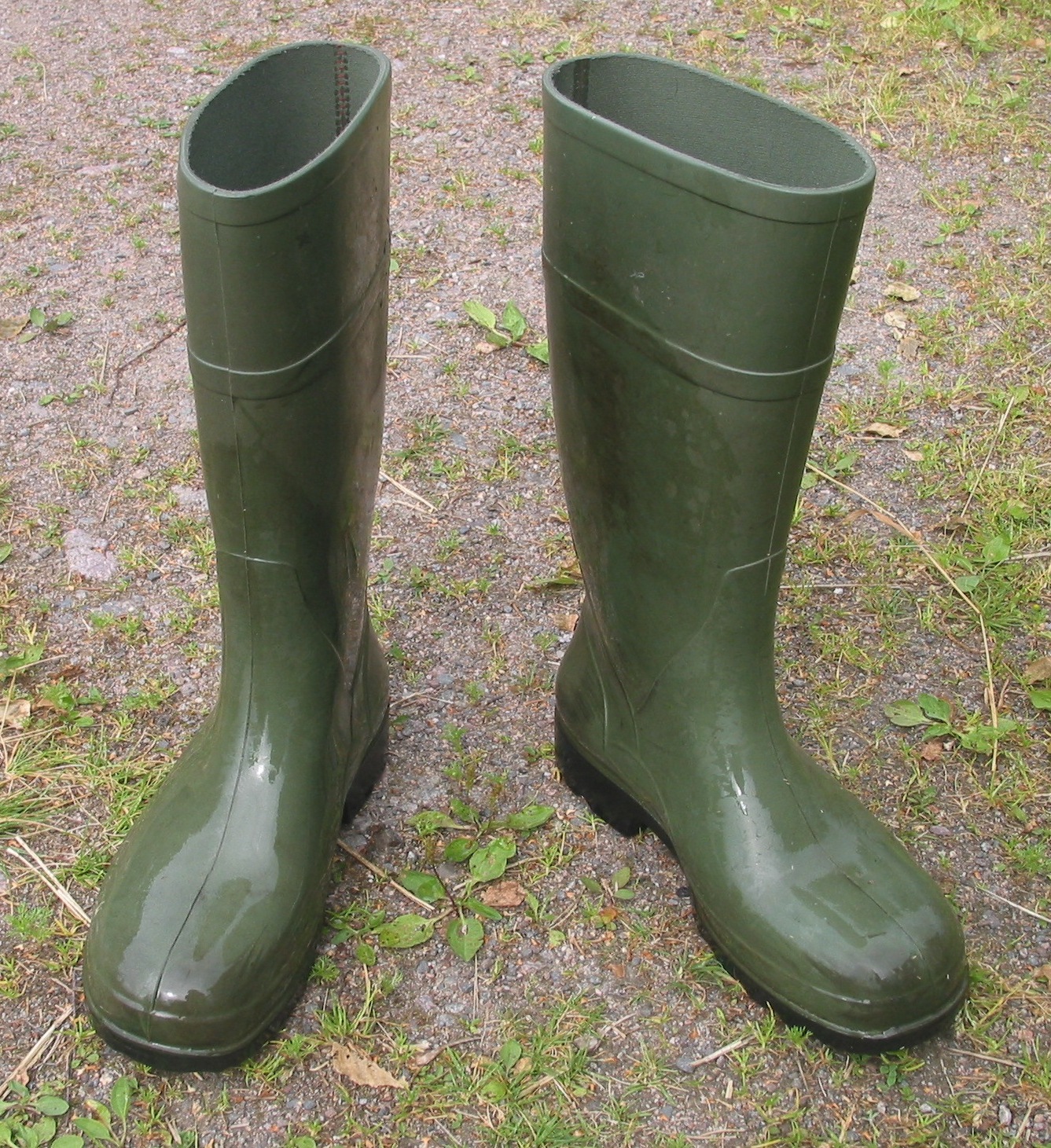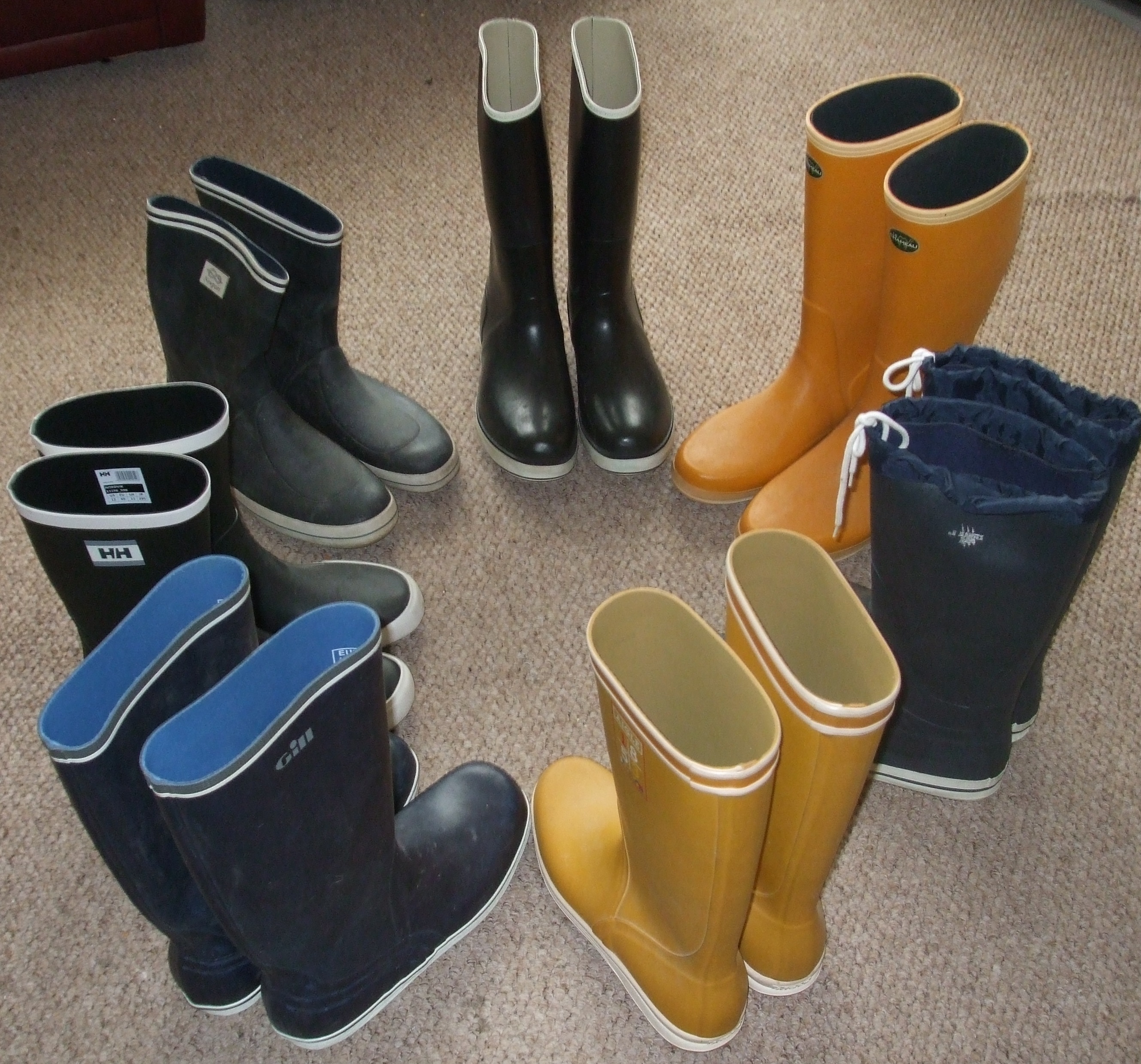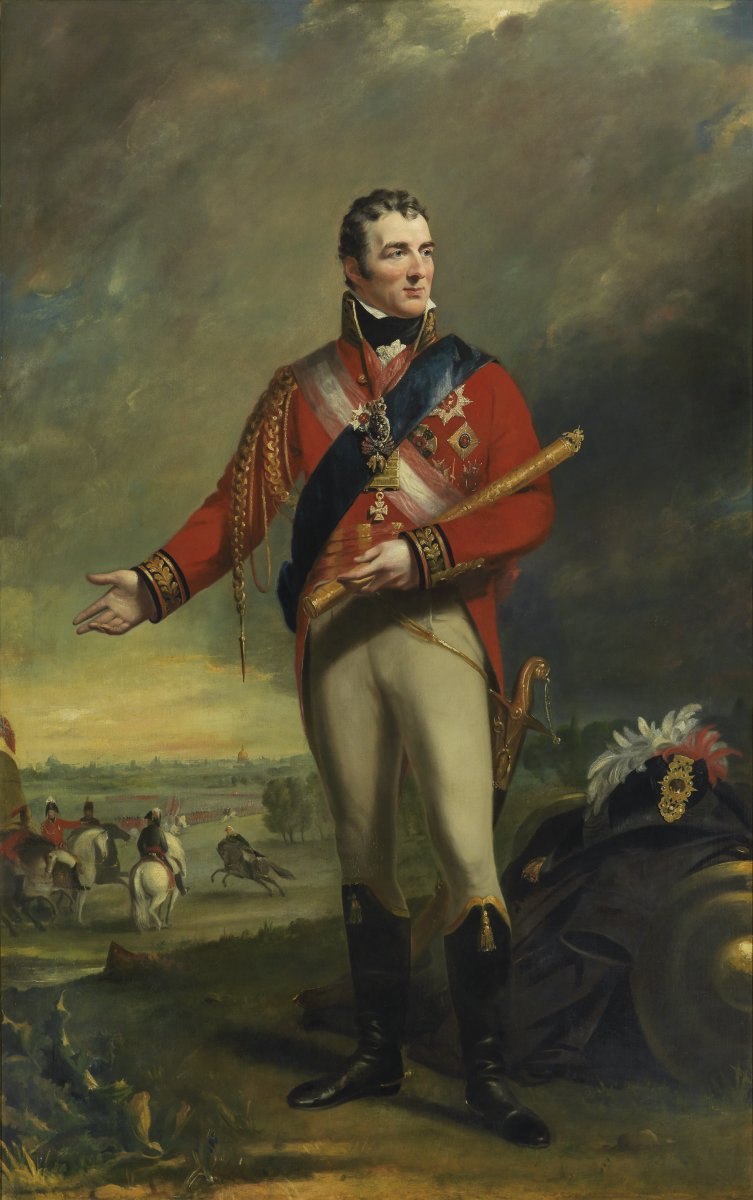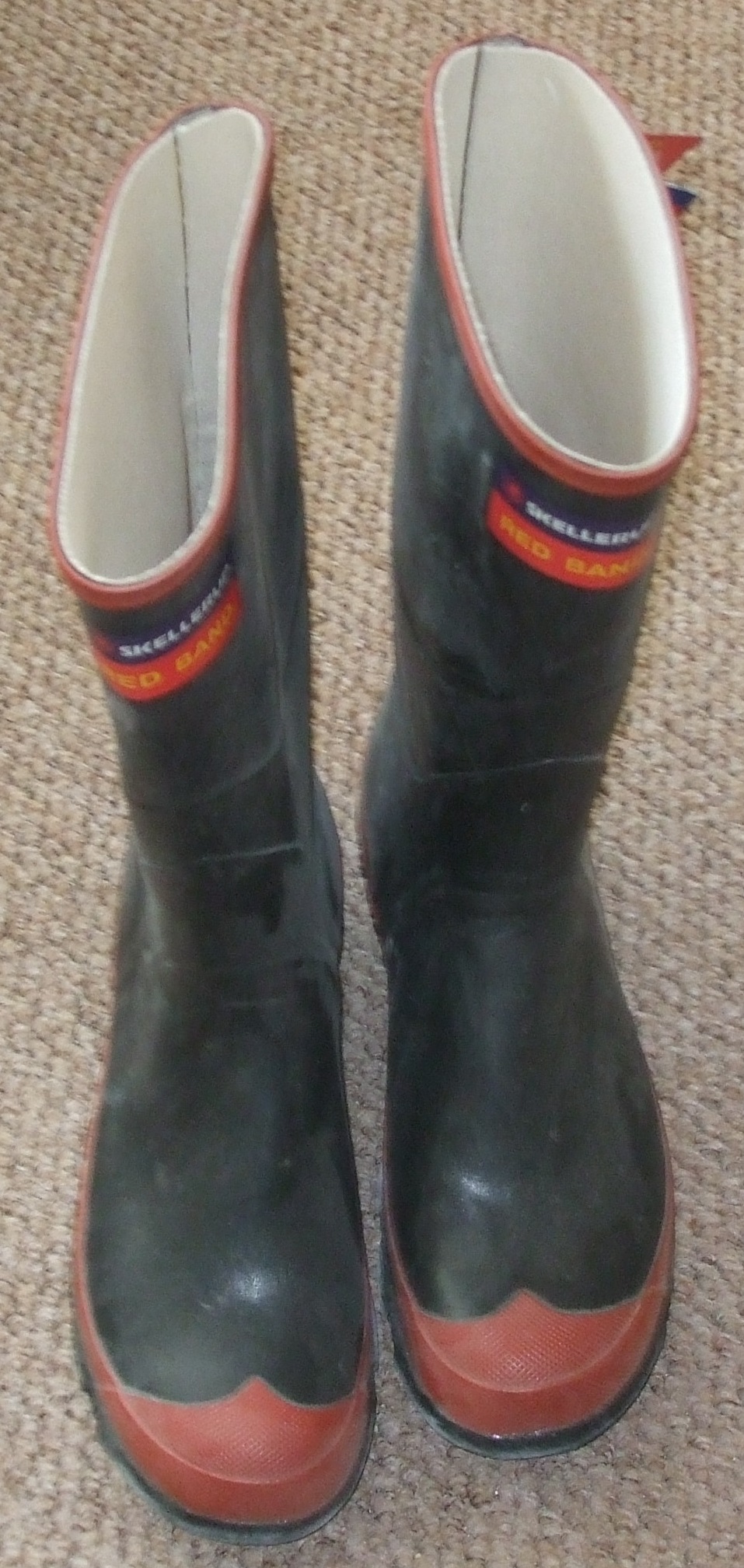Rubber boot on:
[Wikipedia]
[Google]
[Amazon]

 The Wellington boot was originally a type of leather boot adapted from Hessian boots, a style of military riding boot. They were worn and popularised by Arthur Wellesley, 1st Duke of Wellington. The "Wellington" boot became a staple of practical foot wear for the British aristocracy and middle class in the early 19th century. The name was subsequently given to waterproof boots made of
The Wellington boot was originally a type of leather boot adapted from Hessian boots, a style of military riding boot. They were worn and popularised by Arthur Wellesley, 1st Duke of Wellington. The "Wellington" boot became a staple of practical foot wear for the British aristocracy and middle class in the early 19th century. The name was subsequently given to waterproof boots made of
 Wellington boots in contemporary usage are waterproof and are most often made from rubber or polyvinyl chloride (PVC), a
Wellington boots in contemporary usage are waterproof and are most often made from rubber or polyvinyl chloride (PVC), a
 The Duke of Wellington instructed his shoemaker, Hoby of St. James's Street, London, to modify the 18th-century Hessian boot. The resulting new boot was fabricated in soft calfskin leather, had the trim removed and was cut to fit more closely around the leg. The heels were low cut, stacked around an inch (2.5 centimetres), and the boot stopped at mid-calf. It was suitably hard-wearing for riding, yet smart enough for informal evening wear. The boot was dubbed the ''Wellington'' and the name has stuck in English ever since. In the 1815 portrait by James Lonsdale, the Duke can be seen wearing the more formal Hessian style boots, which are tasselled.
Wellington's utilitarian new boots quickly caught on with patriotic British gentlemen eager to emulate their war hero. Considered fashionable and foppish in the best circles and worn by
The Duke of Wellington instructed his shoemaker, Hoby of St. James's Street, London, to modify the 18th-century Hessian boot. The resulting new boot was fabricated in soft calfskin leather, had the trim removed and was cut to fit more closely around the leg. The heels were low cut, stacked around an inch (2.5 centimetres), and the boot stopped at mid-calf. It was suitably hard-wearing for riding, yet smart enough for informal evening wear. The boot was dubbed the ''Wellington'' and the name has stuck in English ever since. In the 1815 portrait by James Lonsdale, the Duke can be seen wearing the more formal Hessian style boots, which are tasselled.
Wellington's utilitarian new boots quickly caught on with patriotic British gentlemen eager to emulate their war hero. Considered fashionable and foppish in the best circles and worn by

 The Wellington boot was originally a type of leather boot adapted from Hessian boots, a style of military riding boot. They were worn and popularised by Arthur Wellesley, 1st Duke of Wellington. The "Wellington" boot became a staple of practical foot wear for the British aristocracy and middle class in the early 19th century. The name was subsequently given to waterproof boots made of
The Wellington boot was originally a type of leather boot adapted from Hessian boots, a style of military riding boot. They were worn and popularised by Arthur Wellesley, 1st Duke of Wellington. The "Wellington" boot became a staple of practical foot wear for the British aristocracy and middle class in the early 19th century. The name was subsequently given to waterproof boots made of rubber
Rubber, also called India rubber, latex, Amazonian rubber, ''caucho'', or ''caoutchouc'', as initially produced, consists of polymers of the organic compound isoprene, with minor impurities of other organic compounds. Thailand, Malaysia, an ...
and they are no longer associated with a particular class. They are now commonly used for a range of agricultural and outdoors pursuits.
Design and use
 Wellington boots in contemporary usage are waterproof and are most often made from rubber or polyvinyl chloride (PVC), a
Wellington boots in contemporary usage are waterproof and are most often made from rubber or polyvinyl chloride (PVC), a halogenated
In chemistry, halogenation is a chemical reaction that entails the introduction of one or more halogens into a compound. Halide-containing compounds are pervasive, making this type of transformation important, e.g. in the production of polymers, ...
polymer
A polymer (; Greek '' poly-'', "many" + ''-mer'', "part")
is a substance or material consisting of very large molecules called macromolecules, composed of many repeating subunits. Due to their broad spectrum of properties, both synthetic a ...
. They are usually worn when walking on wet or muddy ground, or to protect the wearer from heavy showers and puddles. They are generally just below knee-high although shorter boots are available.
The "Wellington" is a common and necessary safety or hygiene shoe in diverse industrial settings: for heavy industry with an integrated reinforced toe; protection from mud and grime in mines, from chemical spills in chemical plants and from water, dirt, and mud in horticultural and agricultural work; and serving the high standard of hygiene required in food processing plants, operating theatres, and dust-free clean rooms for electronics manufacture.
Sailing wear 200px, Crew members wearing Helly Hansen suits
Sailing wear is a type of clothing for sailing. It protects the sailor from water and insulates the body on board a vessel.
There are different types in use, the most premier sailing wear is the ...
includes short and tall sailing wellingtons with non-marking, slip-resistant soles to avoid damage to a boat's deck. These boots require thermal socks to be worn underneath as the rubber does not provide enough warmth.
History
Origins
 The Duke of Wellington instructed his shoemaker, Hoby of St. James's Street, London, to modify the 18th-century Hessian boot. The resulting new boot was fabricated in soft calfskin leather, had the trim removed and was cut to fit more closely around the leg. The heels were low cut, stacked around an inch (2.5 centimetres), and the boot stopped at mid-calf. It was suitably hard-wearing for riding, yet smart enough for informal evening wear. The boot was dubbed the ''Wellington'' and the name has stuck in English ever since. In the 1815 portrait by James Lonsdale, the Duke can be seen wearing the more formal Hessian style boots, which are tasselled.
Wellington's utilitarian new boots quickly caught on with patriotic British gentlemen eager to emulate their war hero. Considered fashionable and foppish in the best circles and worn by
The Duke of Wellington instructed his shoemaker, Hoby of St. James's Street, London, to modify the 18th-century Hessian boot. The resulting new boot was fabricated in soft calfskin leather, had the trim removed and was cut to fit more closely around the leg. The heels were low cut, stacked around an inch (2.5 centimetres), and the boot stopped at mid-calf. It was suitably hard-wearing for riding, yet smart enough for informal evening wear. The boot was dubbed the ''Wellington'' and the name has stuck in English ever since. In the 1815 portrait by James Lonsdale, the Duke can be seen wearing the more formal Hessian style boots, which are tasselled.
Wellington's utilitarian new boots quickly caught on with patriotic British gentlemen eager to emulate their war hero. Considered fashionable and foppish in the best circles and worn by dandies
A dandy is a man who places particular importance upon physical appearance, refined language, and leisurely hobbies, pursued with the appearance of nonchalance. A dandy could be a self-made man who strove to imitate an aristocratic lifestyle desp ...
, such as Beau Brummell, they remained the main fashion for men through the 1840s. In the 1850s they were more commonly made in the calf-high version, and in the 1860s they were both superseded by the ankle boot, except for riding. Wellington is one of the two British Prime Ministers to have given his name to an item of clothing, the other being Sir Anthony Eden (see Anthony Eden hat) whilst Sir Winston Churchill
Sir Winston Leonard Spencer Churchill (30 November 187424 January 1965) was a British statesman, soldier, and writer who served as Prime Minister of the United Kingdom twice, from 1940 to 1945 during the Second World War, and again from 1 ...
gave his name to a cigar, and William Gladstone (four times prime minister between 1868 and 1894) gave his to the Gladstone Bag, the classic doctor's portmanteau
A portmanteau word, or portmanteau (, ) is a blend of wordsHiram Hutchinson met
 The lower cost and ease of rubber "Wellington" boot manufacture, and being entirely waterproof, lent itself immediately to being the preferred protective material to leather in all forms of industry. Increased attention to occupational health and safety requirements led to the
The lower cost and ease of rubber "Wellington" boot manufacture, and being entirely waterproof, lent itself immediately to being the preferred protective material to leather in all forms of industry. Increased attention to occupational health and safety requirements led to the
 In
In
Charles Goodyear
Charles Goodyear (December 29, 1800 – July 1, 1860) was an American self-taught chemist and manufacturing engineer who developed vulcanized rubber, for which he received patent number 3633 from the United States Patent Office on June 15, 1844. ...
, who had just invented the sulfur vulcanisation
Sulfur vulcanization is a chemical process for converting natural rubber or related polymers into materials of varying hardness, elasticity, and mechanical durability by heating them with sulfur or sulfur-containing compounds. Sulfur forms cros ...
process for natural rubber. Hutchinson bought the patent to manufacture footwear and moved to France to establish ''À l'Aigle'' ("At the Eagle") in 1853, to honour his home country. Today the company is simply called Aigle. In a country where 95% of the population were working on fields with wooden clogs as they had been for generations, the introduction of the wholly waterproof, Wellington-type rubber boot became an instant success: farmers would be able to come back home with clean, dry feet.
Production in World War I
Production of the Wellington boot was dramatically boosted with the advent ofWorld War I
World War I (28 July 1914 11 November 1918), often abbreviated as WWI, was one of the deadliest global conflicts in history. Belligerents included much of Europe, the Russian Empire, the United States, and the Ottoman Empire, with fightin ...
and a requirement for footwear suitable for the conditions in Europe's flooded and muddy trenches
A trench is a type of excavation or in the ground that is generally deeper than it is wide (as opposed to a wider gully, or ditch), and narrow compared with its length (as opposed to a simple hole or pit).
In geology, trenches result from erosi ...
. The North British Rubber Company (now Hunter Boot Ltd) was asked by the War Office
The War Office was a department of the British Government responsible for the administration of the British Army between 1857 and 1964, when its functions were transferred to the new Ministry of Defence (MoD). This article contains text from ...
to construct a boot suitable for such conditions. The mills ran day and night to produce immense quantities of these trench boots. In total, 1,185,036 pairs were made to meet the British Army
The British Army is the principal land warfare force of the United Kingdom, a part of the British Armed Forces along with the Royal Navy and the Royal Air Force. , the British Army comprises 79,380 regular full-time personnel, 4,090 Gurk ...
's demands.
Production in World War II
InWorld War II
World War II or the Second World War, often abbreviated as WWII or WW2, was a world war that lasted from 1939 to 1945. It involved the vast majority of the world's countries—including all of the great powers—forming two opposing ...
, Hunter Boot was again requested to supply vast quantities of Wellington and thigh boots. 80% of production was of war materials – from (rubber) ground sheets to life belts and gas masks. In the Netherlands
)
, anthem = ( en, "William of Nassau")
, image_map =
, map_caption =
, subdivision_type = Sovereign state
, subdivision_name = Kingdom of the Netherlands
, established_title = Before independence
, established_date = Spanish Netherl ...
, the British forces were working in flooded conditions which demanded Wellingtons and thigh boots in vast supplies.
By the end of the war in 1945, the Wellington had become popular among men, women and children for wet weather wear. The boot had developed to become far roomier with a thick sole and rounded toe. Also, with the rationing of that time, labourers began to use them for daily work.
Post-war
 The lower cost and ease of rubber "Wellington" boot manufacture, and being entirely waterproof, lent itself immediately to being the preferred protective material to leather in all forms of industry. Increased attention to occupational health and safety requirements led to the
The lower cost and ease of rubber "Wellington" boot manufacture, and being entirely waterproof, lent itself immediately to being the preferred protective material to leather in all forms of industry. Increased attention to occupational health and safety requirements led to the steel toe
This is a list of characters appearing in the animated series ''Kim Possible''.
Overview
Team Possible Kim Possible
* Voiced by Christy Carlson Romano and Dakota Fanning (young)
* Portrayed by Sadie Stanley
Kimberly Ann "Kim" Possible is ...
or steel-capped Wellington: a protective (commonly internal) toe-capping to protect the foot from crush and puncture injuries. Although traditionally made of steel, the reinforcement may be a composite or a plastic material such as thermoplastic polyurethane (TPU). Such steel-toe Wellingtons are nearly indispensable in an enormous range of industry and are often mandatory wear to meet local occupational health and safety legislation or insurance requirements.
In July 1956, the Monopolies and Restrictive Practices Commission published its ''Report on the Supply of Certain Rubber Footwear'', which covered rubber boots of all kinds including wellingtons and overboots. This 107-page official publication addressed contemporary concerns about unfair pricing of rubber footwear manufactured in the UK or imported from overseas. The appendices include lists of rubber footwear manufacturers and price-lists of each company's range of wellington boots available in the mid-1950s.
Green Wellington boots, introduced by Hunter Boot Ltd in 1955, gradually became a shorthand for "country life" in the UK. In 1980, sales of their boots skyrocketed after Lady Diana Spencer (future Princess Diana) was pictured wearing a pair on the Balmoral estate during her courtship with Prince Charles.
Usage and terminology
Australia
Though most commonly called "gumboots", an alternative name, "Blucher Boot", is occasionally used by some older Australians. Blücher was Wellington's colleague at theBattle of Waterloo
The Battle of Waterloo was fought on Sunday 18 June 1815, near Waterloo, Belgium, Waterloo (at that time in the United Kingdom of the Netherlands, now in Belgium). A French army under the command of Napoleon was defeated by two of the armie ...
and there is speculation that some early emigrants to Australia, remembering the battle, may have confused a different design the Blucher shoe developed by Blucher. The Australian poet Henry Lawson
Henry Archibald Hertzberg Lawson (17 June 1867 – 2 September 1922) was an Australian writer and bush poet. Along with his contemporary Banjo Paterson, Lawson is among the best-known Australian poets and fiction writers of the colonial perio ...
wrote a poem to a pair of Blucher Boots in 1890.
North America
While usually called rubber boots, but sometimesgaloshes
Galoshes, also known as dickersons, gumshoes, rubbers, or overshoes, are a type of rubber boot that is slipped over shoes to keep them from getting muddy or wet. In the United States, the word ''galoshes'' may be used interchangeably with boo ...
, mud boots, rain boots, mucking boots, or billy boots, in the United States, the terms "gumboots", "wellies", "wellingtons", and "rainboots" are preferred in Canada. Gumboots are popular in Canada during spring, when melting snows leave wet and muddy ground. Young people can be seen wearing them to school or university and taking them to summer camps. They are an essential item for farmers, and many fishermen, often being accompanied by hip waders.
While green is popular in Britain, red-soled black rubber boots are often seen in the United States, in addition to Canadian styles. Rubber boots specifically made for cold weather, lined with warm insulating material, are especially popular practical footwear for Canadian winters. This same style of lined boot is also popular among those who work in or near the ocean as one can wade in and out of shallow, but cold, ocean water, while staying dry and warm.
In the US white mid-calf rubber boots are worn by workers on shrimp boats and construction workers pouring concrete.
Leather boots similar to Wellington's original Hessian boots have been marketed in North America as "Ranch Wellingtons" or "Western Wellingtons". These boots have more rounded toes, lower heels, and less radically scalloped tops than typical "cowboy boot
Cowboy boots are a specific style of riding boot, historically worn by cowboys. They have a high heel that is traditionally made of stacked leather, rounded to pointed toe, high shaft, and, traditionally, no lacing. Cowboy boots are normally ma ...
s".
New Zealand
 In
In New Zealand
New Zealand ( mi, Aotearoa ) is an island country in the southwestern Pacific Ocean. It consists of two main landmasses—the North Island () and the South Island ()—and over 700 smaller islands. It is the sixth-largest island count ...
, Wellingtons are called "gumboots", "wellies", or "Redbands" (after a popular Skellerup brand) and are considered essential footwear for farmers. Gumboots are often referred to in New Zealand popular culture such as the rurally-based '' Footrot Flats'' comic strip. The farming town of Taihape
Taihape is in the Rangitikei District of the North Island of New Zealand. It serves a large rural community. State Highway 1, which runs North to South through the centre of the North Island, passes through the town.
History and culture
Early ...
in the North Island proclaims itself "Gumboot capital of the World" and has annual competitions and events such as Gumboot Day, where gumboots are thrown. Most gumboots are black, but those worn by abattoir
A slaughterhouse, also called abattoir (), is a facility where animals are slaughtered to provide food. Slaughterhouses supply meat, which then becomes the responsibility of a packaging facility.
Slaughterhouses that produce meat that is no ...
workers, butchers, fishermen and by hospital operating theatre staff and surgeons are white, and children's sizes come in multiple colours.
The term "gum boot" in New Zealand is thought to derive from the 19th-century kauri-gum diggers, who wore this footwear, or perhaps because the boots were made from gum rubber. The term is often abbreviated to "gummies". New Zealand comedy character Fred Dagg
Fred Dagg is a fictional character from New Zealand created and acted on stage, film and television by satirist John Clarke. Clarke appeared on New Zealand TV screens as Dagg during the mid to late 1970s, " taking the piss" out of the post-pion ...
paid tribute to this iconic footwear in his song "Gumboots", a modified version of Billy Connolly
Sir William Connolly (born 24 November 1942) is a Scottish actor, retired comedian, artist, writer, musician, and presenter. He is sometimes known, especially in his homeland, by the Scots nickname the Big Yin ("the Big One"). Known for his ...
's "If It Wisnae Fur Yer Wellies".
Nordic countries
The boots are very popular in Scandinavian countries, with conditions and climate similar to Canada. In fact, before its entry into the mobile phone business, rubber boots were among the best-known products ofNokia
Nokia Corporation (natively Nokia Oyj, referred to as Nokia) is a Finnish multinational telecommunications, information technology, and consumer electronics corporation, established in 1865. Nokia's main headquarters are in Espoo, Finland, i ...
. Both the Finnish Defence Forces and the Swedish Armed Forces
The Swedish Armed Forces ( sv, Försvarsmakten, "the Defense Force") is the government agency that forms the armed forces of Sweden, tasked with the defense of the country as well as with promoting Sweden's wider interests, supporting internati ...
issue rubber boots to all soldiers for use in wet conditions and during the winter with felt liners.
Russia
In Russia rubber boots were first introduced in the 1920s. Immediately, they became extremely popular because of Russian weather conditions. During the rule ofJoseph Stalin
Joseph Vissarionovich Stalin (born Ioseb Besarionis dze Jughashvili; – 5 March 1953) was a Georgian revolutionary and Soviet political leader who led the Soviet Union from 1924 until his death in 1953. He held power as General Secretar ...
, 17 rubber-boot factories were built in different parts of the Soviet Union
The Soviet Union,. officially the Union of Soviet Socialist Republics. (USSR),. was a List of former transcontinental countries#Since 1700, transcontinental country that spanned much of Eurasia from 1922 to 1991. A flagship communist state, ...
. Along with valenki
Valenki ( rus, ва́ленки, p=ˈvalʲɪnkʲɪ; sg valenok ( rus, ва́ленок, p=ˈvalʲɪnək)) are traditional Russian winter footwear, essentially felt boots: the name ''valenok'' literally means "made by felting". They are not wate ...
in winter, rubber boots became ''the'' traditional footwear in springs and autumns.
When Nikita Khrushchev came to power, the boot became charged politically in the context of the "Battle for Modesty" campaign, where rubber footwear was proclaimed as "socialism style" (thus fashionable), while leather, which was obviously more expensive, was derided as "capitalism style" (thus unfashionable). During the period 1961–1964, leather footwear disappeared from Soviet shops. When Leonid Brezhnev came to power in 1964, the usual leather footwear returned to shops, and rubber boots quickly lost their popularity, returning to their original role of utility footwear.
Nowadays, Wellington boots in Russia have the same role as in most countries.
Spain
The most commonly used terms are "botas de pocero" (digger's boots) and "botas de agua" (water boots).United Kingdom
Wellington boots are a commonly used form of waterproof footwear in the UK and are usually referred to as "wellies".See also
*British Country Clothing
British country clothing or English country clothing is the traditional attire worn by men and women in rural Britain; it is the choice of clothing when taking part in outdoor sports such as equestrian pursuits, shooting, fishing and during gener ...
* Galoshes
Galoshes, also known as dickersons, gumshoes, rubbers, or overshoes, are a type of rubber boot that is slipped over shoes to keep them from getting muddy or wet. In the United States, the word ''galoshes'' may be used interchangeably with boo ...
* Mackintosh
* Paddington Bear
Paddington Bear is a fictional character in children's literature. He first appeared on 13 October 1958 in the children's book ''A Bear Called Paddington'' and has been featured in more than twenty books written by British author Michael Bond, a ...
* Waders (footwear)
Waders denotes a waterproof boot or overalls extending from the foot to the thigh, the chest or the neck. They are traditionally made from vulcanised rubber, but available in more modern PVC, neoprene and Gore-Tex variants. Waders are generally ...
* William's Wish Wellingtons
References
External links
{{Authority control Boots British inventions Arthur Wellesley, 1st Duke of Wellington History of fashion Maritime culture Caving equipment 19th-century fashion 20th-century fashion 21st-century fashion History of clothing (Western fashion)